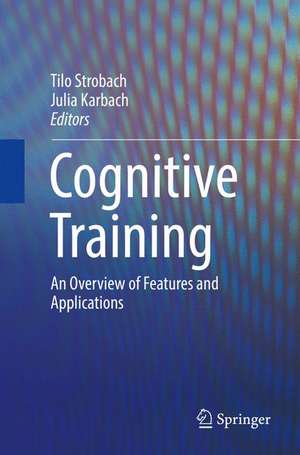Cognitive Training: An Overview of Features and Applications
Editat de Tilo Strobach, Julia Karbachen Limba Engleză Paperback – 30 mai 2018
This book offers a comprehensive overview of empirical findings and methodological approaches of cognitive training research in different cognitive domains (memory, executive functions, etc.), types of training (working memory training, video game training, physical training, etc.), age groups (from children to young and older adults), target populations (children with developmental disorders, aging workers, MCI patients etc.), settings (laboratory-based studies, applied studies in clinical and educational settings), and methodological approaches (behavioral studies, neuroscientific studies). Chapters feature theoretical models that describe the mechanisms underlying training-induced cognitive and neural changes.
Cognitive Training: An Overview of Features and Applications will be of interest to researchers, practitioners, students, and professors in the fields of psychology and neuroscience.
| Toate formatele și edițiile | Preț | Express |
|---|---|---|
| Paperback (2) | 580.36 lei 6-8 săpt. | |
| Springer International Publishing – 30 mai 2018 | 580.36 lei 6-8 săpt. | |
| Springer International Publishing – 21 oct 2021 | 590.81 lei 6-8 săpt. | |
| Hardback (1) | 958.38 lei 6-8 săpt. | |
| Springer International Publishing – 21 oct 2020 | 958.38 lei 6-8 săpt. |
Preț: 580.36 lei
Preț vechi: 682.77 lei
-15% Nou
Puncte Express: 871
Preț estimativ în valută:
111.05€ • 116.24$ • 92.43£
111.05€ • 116.24$ • 92.43£
Carte tipărită la comandă
Livrare economică 31 martie-14 aprilie
Preluare comenzi: 021 569.72.76
Specificații
ISBN-13: 9783319932187
ISBN-10: 3319932187
Pagini: 211
Ilustrații: XI, 211 p. 6 illus., 2 illus. in color.
Dimensiuni: 155 x 235 mm
Greutate: 0.32 kg
Ediția:1st ed. 2016
Editura: Springer International Publishing
Colecția Springer
Locul publicării:Cham, Switzerland
ISBN-10: 3319932187
Pagini: 211
Ilustrații: XI, 211 p. 6 illus., 2 illus. in color.
Dimensiuni: 155 x 235 mm
Greutate: 0.32 kg
Ediția:1st ed. 2016
Editura: Springer International Publishing
Colecția Springer
Locul publicării:Cham, Switzerland
Cuprins
Chapter 1. Introduction.- Part I: Basic Concepts and Methodology.- Chapter 2. Methods and Designs.- Chapter 3. Theoretical Models of Training and Transfer Effects.- Part II: Plasticity in Different Age Groups.- Chapter 4. Childhood and Adolescence.- Chapter 5. Adult Lifespan.- Part III: Plasticity of Different Cognitive Domains.- Chapter 6. Working Memory.- Chapter 7. Episodic Memory.- Chapter 8. Prospective Memory.- Chapter 9. Executive Functions.- Part IV: Multidomain Trainings.- Chapter 10. Action Video-Game Training and Its Effects on Perception and Attentional Control.- Chapter 11. Video-Game Training and Effects on Executive Functions.- Chapter 12. Mindfulness and Meditation Training.- Chapter 13. Music Training.- Chapter 14. Physical Training.- Part V: Cognitive Training in Applied Contexts.- Chapter 15. Individual Difference and Motivational Effects.- Chapter 16. Educational Application of Working-Memory Training.- Chapter 17. Changes of Electrical Brain Activity After Cognitive Training.- Chapter 18. Cognitive Training in Mild Cognitive Impairment.- Part VI: Outlook.- Chapter 19. The Future of Cognitive Training.
Notă biografică
Tilo Strobach finished his doctoral degree at Humboldt University Berlin. After that he held post-doc positions at this university and at LMU Munich. Currently, Tilo Strobach is full professor for cognitive psychology at the Medical School Hamburg. His research focuses on the analysis of cognitive plasticity as a result of training (e.g., video-game, dual-task, working memory, and task switching training) and cognitive aging. Furthermore, he aims at specifying the cognitive processing architecture in situations that demand executive functions as well as the perception of complex objects.
Julia Karbach is a developmental cognitive psychologist holding a PhD in Psychology from Saarland University. She currently serves as full professor at Goethe-University Frankfurt. Her research interests include neurocognitive development and plasticity across the lifespan, psychocardiology, and the prediction of academic achievement from primary to tertiaryeducation. Her work has been published in numerous leading peer-reviewed international journals.
Textul de pe ultima copertă
This book brings together a cutting edge international team of contributors to critically review the current knowledge regarding the effectiveness of training interventions designed to improve cognitive functions in different target populations. There is substantial evidence that cognitive and physical training can improve cognitive performance, but these benefits seem to vary as a function of the type and the intensity of interventions and the way training-induced gains are measured and analyzed. This book further fulfills the need for clarification of the mechanisms underlying cognitive and neural changes occurring after training.
This book offers a comprehensive overview of empirical findings and methodological approaches of cognitive training research in different cognitive domains (memory, executive functions, etc.), types of training (working memory training, video game training, physical training, etc.), age groups (from children to young andolder adults), target populations (children with developmental disorders, aging workers, MCI patients etc.), settings (laboratory-based studies, applied studies in clinical and educational settings), and methodological approaches (behavioral studies, neuroscientific studies). Chapters feature theoretical models that describe the mechanisms underlying training-induced cognitive and neural changes.
Cognitive Training: An Overview of Features and Applications will be of interest to researchers, practitioners, students, and professors in the fields of psychology and neuroscience.
Caracteristici
Provides a comprehensive overview of state-of-the art cognitive training research for students, scientists and practitioners Discusses theoretical models describing the mechanisms underlying training-induced changes Includes contributions from a team of cutting edge internationally acclaimed experts
